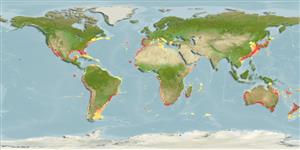Classification / Names
Common names from other countries
Main reference
Size / Weight / Age
Max length : 325 cm TL male/unsexed; (Ref. 2334); max. published weight: 304.6 kg (Ref. 40637); max. reported age: 30 years (Ref. 3209)
Length at first maturity
Lm 230.0, range 245 - 240 cm
Environment
Marine; brackish; reef-associated; oceanodromous (Ref. 51243); depth range 0 - 360 m (Ref. 58018)
Climate / Range
Subtropical, preferred 26°C (Ref. 107945); 45°N - 52°S, 122°W - 180°E
Distribution
Western Atlantic: Mexico, Gulf of Mexico, Brazil to Argentina. Eastern Atlantic: off France southward and around the coast of southern Africa to central Natal, South Africa (Ref. 5578), including the Mediterranean. Possibly two separate populations in southern Africa (Ref. 3209). Western Pacific: Japan to New Zealand. Eastern Pacific: southern California, USA to the Gulf of California in Mexico and Peru.
Countries | FAO areas | Ecosystems | Occurrences | Introductions
Short description
Dorsal
spines
(total): 0;
Dorsal
soft rays
(total): 0;
Anal
spines: 0;
Anal
soft rays: 0. A large shark to with a bluntly pointed, broad snout, narrow, bent cusps on the upper teeth, and with no interdorsal ridge (Ref. 5578). Grey to bronzy in color, white below (Ref. 5578); fins mostly plain except for dusky tips on pelvic fins, as well as dusky to black tips and rear edges on pectoral fins (Ref. 9997).
IUCN Red List Status (Ref. 115185)
Threat to humans
Traumatogenic (Ref. 4690)
Human uses
Fisheries: minor commercial; gamefish: yes
More information
ReferencesAquacultureAquaculture profileStrainsGeneticsAllele frequenciesHeritabilityDiseasesProcessingMass conversion
Tools
Special reports
Download XML
Internet sources
Estimates of some properties based on models
Phylogenetic diversity index
PD50 = 0.5000 many relatives (e.g. carps) 0.5 - 2.0 few relatives (e.g. lungfishes)
Trophic Level
4.5 ±0.0 se; Based on diet studies.
Resilience
Very Low, minimum population doubling time more than 14 years (K=0.04; tm=5-20; tmax=30; Fec=7)
Vulnerability
Very high vulnerability (87 of 100)
Price category
